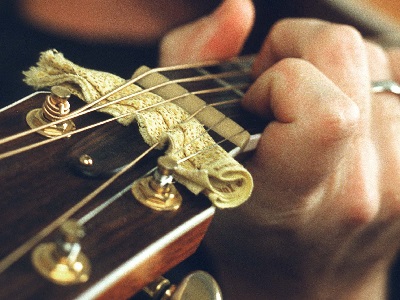How Are Major And Minor Guitar Chords Formed And Played?
 A chord is defined as 3 or more different musical notes being played at the same time. In today’s music, the majority of chords played are often made up of major and minor chords.
A chord is defined as 3 or more different musical notes being played at the same time. In today’s music, the majority of chords played are often made up of major and minor chords.
In this lesson, I will be teaching you some simple music theory in order to show you how the basic chords are formed. You will also learn a list of the fundamental chords that every beginner should know.
First, A Recap of the Major Scales
Now, chords are always formed and named with reference to the major scales on the guitar. It is important that you have some basic knowledge on guitar scales before continuing in this lesson. If you don’t, please take 10 minutes of your time to familiarize yourself with them here.
Once you are done reading up and have a sound knowledge about scales, let’s carry on with our lesson. To begin with, I’m going to lay out the notes of the C major scale below.

For your convenience, I had also indicated the scale intervals in this table. Basically, a musical interval is the distance between 2 notes. The “formula” for creating a major chord is to use the I, III and V notes of the major scale. From the table above, we can see that C major chord is made up of C, E and G notes.
Here’s the representative tablature of the C major chord with the following notes: C, E, G, C, E
e|—-0—-|
B|—-1—-|
G|—-0—-|
D|—-2—-|
A|—-3—-|
E|———|
Let’s Try Another Example With the F Major Chord
Is the C major example simple enough? Now, let’s do another example using the F major scale.

Using the I, III and V formula again, we obtain the notes F, A and C to create the F major chord. The corresponding tablature form for the F major chord can be found below.
e|—-1—-|
B|—-1—-|
G|—-2—-|
D|—-3—-|
A|—-3—-|
E|—-1—-|
How Are Minor Chords Formed?
With some effort, I’m sure you find the major chords to be a piece of cake. So, let’s move on to minor chords. Like the major chords, we can utilize a similar formula (I, IIIb and V) to derive any minor chord is from the major scale.
Using the C major scale as an example and by flatting the III note of the scale (from E to Eb), we get a minor 3rd interval. From the table below, you can derive that the C minor chord consists of the following notes: C, Eb and G.

e|—-3—-|
B|—-4—-|
G|—-5—-|
D|—-5—-|
A|—-3—-|
E|———|
C minor chord
Let’s Do Another Example With F Minor
In order to get the F minor chord, we apply the formula I, IIIb and V to the F major scale. This time around, I want you to do the exercise yourself and try to derive the notes of an F minor chord.
Did you get the following notes: F, Ab and C? If you did, well done. If you made a mistake, check the table above again and see if you can figure out what went wrong.
e|—-1—-|
B|—-1—-|
G|—-1—-|
D|—-3—-|
A|—-3—-|
E|—-1—-|
F minor chord
What Are The Differences Between a Major And Minor Chord?
Here’s something I want you to do with your guitar. Play the F maj and the F min chord one after the other. Can you hear that the major chord sounds happy and positive while the minor chord sounds mellow and sad?
With that, this sums up the theoretical portion of the lesson and let’s get your fingers busy. Below is a list of essential chords every guitarist needs to master in the key of C.
Cmaj Dm Em Fmaj Gmaj Am
e|—–0——1—–0—-1——-3——0—–|
B|—-1——2—–0—-1——-0——1——|
G|—-0——3—–0—-2——-0——2—–|
D|—-2——0—–2—-3——-0——2—–|
A|—-3————-2—-3——-2——0—–|
E|——————-0—-1——–3————-|
Besides the chords above, I have also listed 3 other open-string chords you MUST KNOW.
Dmaj Emaj Amaj
e|—-2—-0—-0—-|
B|—-3—-0—-2—-|
G|—-2—-1—-2—-|
D|—-0—-2—-2—-|
A|———2—-0—-|
E|———0———|
I highly recommend that you practice them until you can play them fluently. To inject a little fun, I had formed a simple chord progression using some of these chords and introduced an easy strumming rhythm.
Fun With Major & Minor Chords
Strum the chord progression (in C key) according to the rhythm given for each bar. Do download and listen to the mp3 file if you need help with getting the rhythm correct.
| C maj | G maj | Am | F maj |

Download .gtp5 or .mp3 file ( Right-click Save Target as… )
Does this sound familiar? This is the core strumming pattern for Collide by Howie Day in the key of C. The good news is there are many other great songs written using this simple progression and can be regularly found in popular music today. So, if you manage to master the chords changing for this progression, you can easily strum along to many recognizable tunes!
With that, we had come to the end of this lesson. I want you to play around and experiment with the new chords that you had learnt today. Have fun and don’t forget to practice regularly!!!
Looking For Step-By-Step Video Guitar Lessons?
Trusted by 200,000+ students, Jamorama is the leading provider of guitar courses. If you are looking for a fun way to learn the guitar and want to play-along to your favorite songs, check out Jamorama today…







Leave A Comment